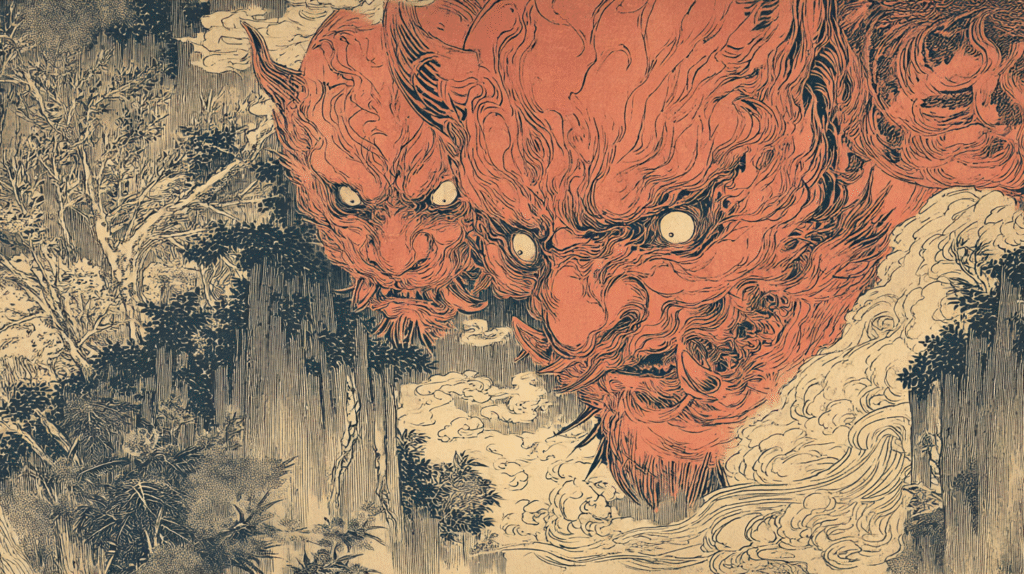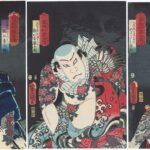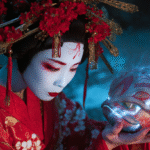In the phenomenally successful anime and manga series Jujutsu Kaisen, which has captivated audiences worldwide since 2020, the primary antagonist is a terrifying entity known as Ryomen Sukuna, the self-proclaimed “King of Curses.” With his four arms, immense power, and malevolent presence, this character has become one of the most iconic villains in contemporary Japanese popular culture. However, what many fans don’t realize is that Ryomen Sukuna is not merely a product of creative imagination, but rather a figure deeply rooted in Japanese historical records and ancient folklore.
The historical Ryomen Sukuna appears in the Nihon Shoki (Chronicles of Japan), one of Japan’s oldest written records compiled in the 8th century. Far from being a fictional creation, he was recorded as a real rebel who defied the early Japanese imperial court in what is now Gifu Prefecture. This article explores the fascinating journey of how an ancient rebel leader transformed through centuries of folklore into the demon king of Jujutsu Kaisen, revealing the deep connections between Japan’s mythological past and its contemporary pop culture.
The Historical Record: A Rebel with Two Faces
The earliest and most authoritative mention of Ryomen Sukuna comes from the Nihon Shoki, specifically in Volume 11, which chronicles the reign of Emperor Nintoku. According to this 8th-century text, in the 65th year of Emperor Nintoku’s reign (approximately the 5th century CE), there lived in Hida Province a remarkable and terrifying individual:
“In Hida Province there was a person called Sukuna. In form, he had one body with two faces, each face oriented in opposite directions, joined at the crown with no back of the head. Each face had its own set of arms and legs. He had knees but no heels. Possessing great strength and moving with swift agility, he wore swords on both left and right, and could use all four hands to wield bows and arrows. Therefore, he did not follow imperial commands, but took pleasure in plundering the people.”
This extraordinary description has puzzled historians for centuries. The account continues to state that Emperor Nintoku, troubled by this rebellion, dispatched Namba no Negohiko Take-furukuma, ancestor of the Wani clan, to subjugate Ryomen Sukuna. The imperial forces ultimately succeeded in defeating and killing the rebel leader.
What makes this historical account particularly intriguing is its matter-of-fact tone. The Nihon Shoki, as an official court history, typically portrayed enemies of the imperial house in negative terms, but the specific details about Sukuna’s unusual physical form suggest something more complex than simple demonization of an enemy.
The Buddhist Transformation: From Demon to Deity
Remarkably, local traditions in the Hida region tell a completely different story about Ryomen Sukuna. The most significant alternative narrative comes from Senko-ji Temple, a Shingon Buddhist temple located in what is now Takayama City, Gifu Prefecture. According to the temple’s founding legend, preserved in the Hida-shi (Records of Hida Province):
“During the reign of the 17th Emperor Nintoku, there was in this province one called Sukuna, who emerged from a cave at Dewa-ga-taira in the same district. His height was eighteen jo (approximately 54 meters or 177 feet), with one head, two faces, and four legs. He was a manifestation of the Bodhisattva Kannon (Avalokitesvara) and founded this temple. At that time, in the earth atop the mountain, there was discovered a stone coffin containing one copy of the Lotus Sutra, one scroll, and one statue of the Thousand-Armed Kannon, from which this mountain temple takes its name.”
This dramatic divergence from the official record presents Ryomen Sukuna not as a rebel or demon, but as a Buddhist saint and temple founder. While modern historians recognize this account as a later Buddhist interpolation (Buddhism wasn’t introduced to Japan until the 6th century, after Sukuna’s time), it reveals how local communities preserved a more positive memory of this figure, suggesting he may have been seen as a protector or leader by the indigenous population.
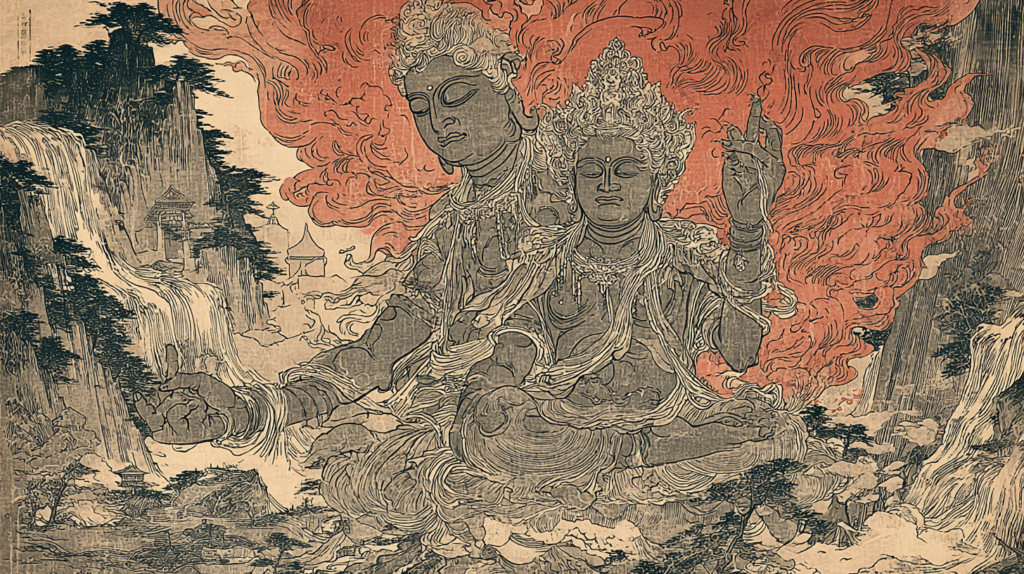
The Hida-bito: Understanding Sukuna’s People
To truly understand Ryomen Sukuna and his significance in both history and Jujutsu Kaisen, we must examine the people he represented: the “Hida-bito” (people of Hida). During the period of the Yamato court‘s expansion (roughly 3rd-7th centuries CE), Japan was not a unified nation but rather a patchwork of different ethnic groups and cultures. The Yamato clan, claiming descent from the sun goddess Amaterasu, gradually extended their control from central Japan outward, encountering and subjugating various indigenous peoples.
These indigenous groups were referred to by various names in ancient texts: “Tsuchigumo” (earth spiders), “Emishi,” and in the case of the Hida region, “Hida-bito.” The Nihon Kouki (Later Chronicle of Japan), compiled in the early 9th century, provides a fascinating glimpse into the persistent otherness of the Hida people. In an official document regarding the pursuit of runaway laborers from Hida, it states:
“The people of Hida, in their speech and appearance, differ from other provinces. Even if they change their names, they cannot be mistaken.”
This remarkable statement, written centuries after Ryomen Sukuna‘s rebellion, indicates that the Hida region maintained its ethnic and cultural distinctiveness well into the Heian period (794-1185). The mountainous terrain of Hida, with its deep valleys and limited access routes, created a natural refuge where indigenous culture could persist longer than in more accessible regions.
Archaeological evidence from the Norikura mountain range and the Kobachigawa River valley supports the existence of a sophisticated pre-Yamato culture in the region. Numerous Jomon period (14,000-300 BCE) and Yayoi period (300 BCE-300 CE) sites have been discovered, showing continuous habitation and cultural development independent of Yamato influence.

The Geography of Resistance
The legend of Ryomen Sukuna is intimately connected to specific locations that still exist today, providing a geographical framework for understanding his historical significance. The cave at Dewa-ga-taira (modern Nyukawa-cho, Takayama City), where Sukuna supposedly emerged and made his last stand, is a massive limestone cavern system that would have provided an ideal defensive position.
Local traditions extend Ryomen Sukuna‘s influence beyond Hida into neighboring Mino Province (southern Gifu Prefecture). Sites such as Gyodo-an temple in Hida-se and Nichiryu-ho Temple in Tonomura preserve legends of Sukuna’s presence. According to these traditions, when Sukuna learned of the approaching imperial army, he led his forces out of Hida to establish defensive positions at strategic mountain passes, attempting to prevent the imperial forces from advancing north through the crucial transportation corridors.
The distribution of these legendary sites suggests that Ryomen Sukuna commanded a coalition that controlled a significant territory spanning multiple provinces. This was not simply a local uprising but potentially a coordinated resistance movement representing the last major stand of the indigenous peoples of central Japan against Yamato expansion.
From Historical Rebel to Mythological Monster
The transformation of Ryomen Sukuna from historical figure to mythological entity followed patterns common in Japanese folklore. Over the centuries, several distinct folkloric traditions merged with the Sukuna legend:
- The Giant (Kyojin) Tradition: Throughout Japan, legends tell of ancient giants who shaped the landscape. Figures like Daidarabotchi were said to have created lakes with their footprints and mountains with the dirt they carried. Ryomen Sukuna‘s reported height of 18 jo in the Buddhist tradition clearly places him within this mythological framework. This gigantification serves to emphasize his superhuman nature and the magnitude of the threat he posed to the established order.
- The Oni (Demon) Tradition: In Hida folklore, Ryomen Sukuna evolved into a bogeyman figure. Parents would warn misbehaving children that “Sukuna will come for you,” similar to how the Namahage demons of Akita Prefecture or the Germanic Krampus function in their respective cultures. This transformation from rebel leader to demon reflects the complex Japanese tradition of vengeful spirits (onryo) and the need to pacify the souls of defeated enemies.
- The Bandit King Tradition: Later medieval traditions portrayed Ryomen Sukuna as a bandit chief similar to Shuten-doji of Mt. Oe or the various bandit leaders who appear in classical Japanese literature. In these versions, Sukuna leads a band of outlaws from his mountain stronghold, raiding settlements and defying authority until defeated by a imperial hero.
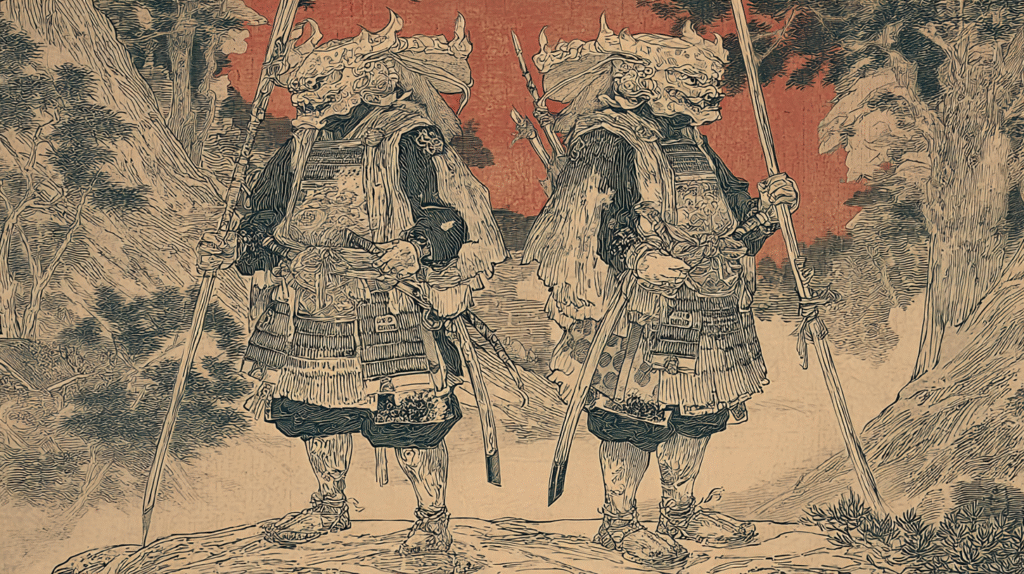
The Modern Resurrection in Jujutsu Kaisen
The 21st-century resurrection of Ryomen Sukuna in Jujutsu Kaisen represents a remarkable synthesis of all these historical and mythological traditions. Creator Gege Akutami has taken the ancient rebel and transformed him into the “King of Curses,” a being of such immense power that he had to be divided into twenty indestructible fingers to be sealed away.
In Jujutsu Kaisen, Ryomen Sukuna maintains his classical attributes—four arms, two faces, overwhelming strength—while adding layers of psychological complexity. He is portrayed not merely as a mindless monster but as an intelligent, calculating entity with his own philosophy and goals. His disdain for weakness and celebration of strength echo the might-makes-right worldview that the historical Sukuna might have embraced in his resistance against the Yamato state.
The Symbolism of Four Arms and Two Faces
The distinctive physical characteristics attributed to Ryomen Sukuna—two faces and four arms—deserve special examination. While the Nihon Shoki presents these as literal physical features, modern historians interpret them symbolically. The duality of faces could represent several concepts:
- Political Duality: Sukuna may have been simultaneously a protector to his people and a terrorist to the Yamato authorities, embodying the dual nature of resistance leadership.
- Religious Syncretism: The two faces might symbolize the merging of indigenous Hida religious practices with incoming Buddhist and Shinto influences, particularly relevant given the Senko-ji Temple tradition.
- Strategic Vision: In military terms, having “eyes in the back of one’s head” suggests exceptional awareness and strategic capability, qualities that would have been essential for a guerrilla leader operating in mountainous terrain.
The four arms clearly connect to Buddhist iconography, particularly the Thousand-Armed Kannon (Senju Kannon), though this association likely developed centuries after the historical Sukuna. In Jujutsu Kaisen, these extra limbs become instruments of destruction, allowing Ryomen Sukuna to perform his devastating techniques with unmatched efficiency.
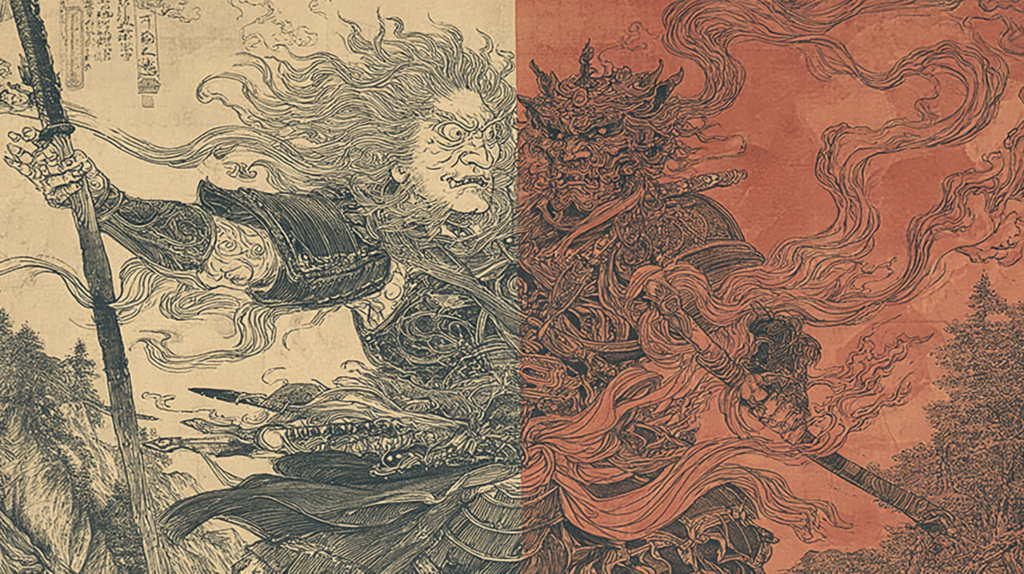
Cultural Memory and Modern Relevance
The enduring power of the Ryomen Sukuna legend lies in its embodiment of fundamental tensions within Japanese society. The conflict between central authority and regional autonomy, between indigenous traditions and imported culture, between order and chaos—these themes resonate as strongly today as they did fifteen centuries ago.
In contemporary Hida (modern Gifu Prefecture), Ryomen Sukuna occupies an ambiguous position in local culture. While the Senko-ji Temple continues to venerate him as a Buddhist saint, local folklore maintains elements of fear and respect. Annual festivals and ritual observances connected to Sukuna sites suggest a continuing need to propitiate his spirit, reflecting the deep Japanese cultural practice of transforming dangerous spirits into protective deities through proper veneration.
The global success of Jujutsu Kaisen has introduced Ryomen Sukuna to an international audience, sparking renewed interest in the historical and mythological roots of the character. This has led to increased tourism to Hida region sites associated with the legend, creating an interesting feedback loop where fictional representation drives interest in historical preservation.
The Archaeological Evidence
While much of the Ryomen Sukuna legend remains in the realm of mythology, archaeological investigations in the Hida region have uncovered evidence of significant social upheaval during the Kofun period (250-538 CE), roughly corresponding to Sukuna’s era. Destruction layers at several sites, changes in pottery styles, and shifts in burial practices all point to a period of conflict and cultural transformation.
Of particular interest are the remains found in cave sites throughout the region. While not directly linkable to Sukuna himself, these sites show evidence of habitation during periods of conflict, supporting the narrative of mountain strongholds serving as bases for resistance against lowland authorities. The famous Dewa-ga-taira cave, traditionally associated with Ryomen Sukuna‘s last stand, shows clear evidence of human use during the appropriate historical period, though linking this specifically to the legendary figure remains impossible.
Conclusion: The Eternal Rebel
The journey of Ryomen Sukuna from 5th-century rebel to 21st-century anime villain represents a remarkable example of cultural continuity and transformation. Each era has reimagined Sukuna according to its own needs and fears: the ancient court historians saw a monstrous rebel, medieval Buddhists discovered a saint, Edo period storytellers created a demon, and modern manga artists have given us the ultimate cursed spirit.
What remains constant throughout these transformations is Sukuna’s role as the ultimate outsider, the one who refuses to submit to authority. In an increasingly globalized and homogenized world, the appeal of such figures only grows stronger. Jujutsu Kaisen‘s Ryomen Sukuna resonates with audiences not just because of his overwhelming power, but because he represents something primal and untamed that modern society has tried to suppress but can never fully eliminate.
The historical Ryomen Sukuna, whoever he truly was, achieved a form of immortality that no military victory could have granted. By refusing to submit to the Yamato court, by fighting to the end for his people and their way of life, he ensured that his name would echo through the centuries. Today, as millions of Jujutsu Kaisen fans around the world thrill to his appearances, Ryomen Sukuna continues his rebellion against authority, order, and the passage of time itself.
In the mountains of Hida, the caves and temples associated with his legend stand as monuments to a forgotten struggle. They remind us that history is written by the victors, but legends belong to everyone. The two faces of Ryomen Sukuna—historical rebel and mythological monster—continue to watch over Japan, challenging each generation to question authority, remember the forgotten, and recognize that even in defeat, defiance can achieve its own form of victory.
References
- Nihon Shoki (Chronicles of Japan)
- Nihon Kouki (Later Chronicle of Japan)
- Hida-shi (Records of Hida Province) – Senko-ji Temple records
- “Hidabito” Archaeological Journal, Vol. 6, No. 1 & 3, 1938
- “Hida Short History” by Goto Shugo, 1934
Disclaimer:
This article draws from Japanese historical sources cited in the references. As classical Japanese texts pose significant linguistic challenges, AI-assisted translation was employed for ancient passages. We welcome any corrections or clarifications from readers with expertise in classical Japanese literature.
All images in this article are AI-generated artistic interpretations created via Midjourney, representing the author’s visualization of Ryomen Sukuna based on the various historical and folkloric descriptions explored in this piece.

